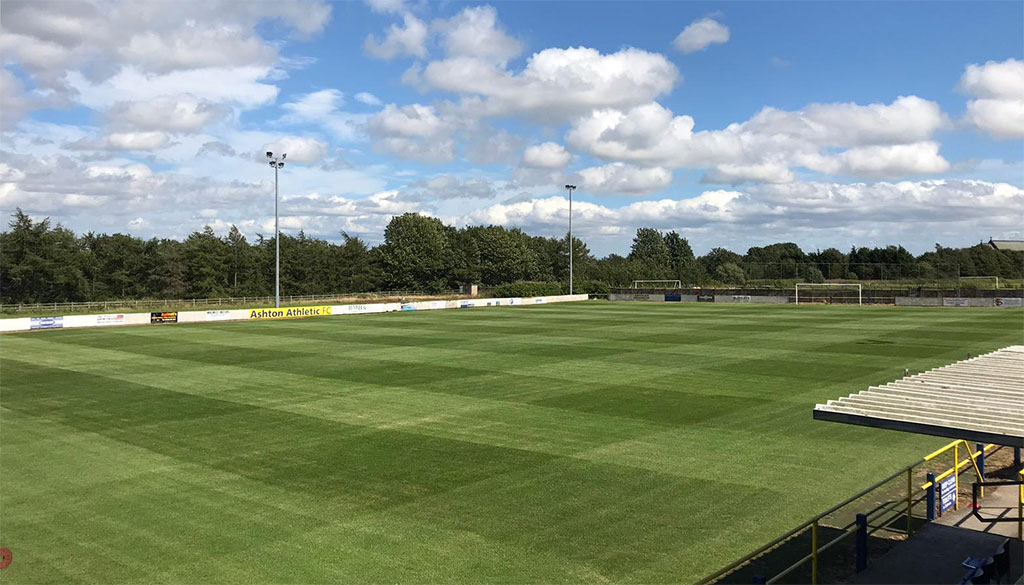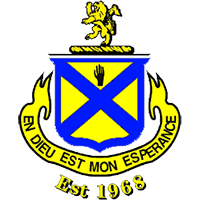
Emblematically Speaking - Ashton Athletic
Tue 8th May 2018 | Ashton Athletic | By Stewart Taylor
The emblem of Ashton Athletic FC is derived from the Ashton-in Makerfield Coat of Arms.
The history of the town of Ashton-in Makerfield is inextricably linked to the Gerard family and, specifically Thomas Gerard who was created Baron Gerard of Bryn in 1611. The family seat was the original Bryn Hall.
Evidence for this abounds in the town with the main street being Gerard Street which features the Gerard Centre shopping area and the Sir Thomas Gerard pub – Wetherspoons.
Given this we would perhaps expect that the town Coat of Arms makes reference to this important family and indeed it does, but not in a way which is entirely clear.
In some ways, the story behind this football club emblem could be described as an understanding of colour. Sounds a bit strange perhaps but all, or at least some, will be revealed.
The football club emblem is a modified version of the Coat of Arms of the Ashton-in-Makerfield Urban District Council which was partly subsumed into Wigan Metropolitan Borough thanks to our old friend the Local Government Act of 1972.
The current Wigan Metropolitan Borough Coat of Arms, whilst incorporating elements which derive from the Coats of Arms other Urban District Councils which became part of the Metropolitan Borough at the same time, does not include any references to the Ashton-in-Makerfield UDC Coat of Arms.
The earliest readily accessible image of the Ashton-in-Makerfield Coat of Arms comes from a George V coronation beaker made in 1911.
This shows a blue shield with a yellow cross and is, at first glance, somewhat at odds with what is generally known about the colours of the Coat of Arms. That comes from the idea that the shield is derived from the Gerard family Coat of Arms which is described heraldically as “argent, a saltire gules”.
Using our knowledge of heraldic terminology, we now know that this simply means a red cross on a white background.
What the 1911 version also shows is a hand in the top section of the shield and a lion rampant forming the crest. There is no immediate reference to either of these devices appearing on the Coat of Arms of the Gerard family, so we need to look elsewhere for an understanding of their significance.
The hand shown on the shield is described heraldically as a sinister hand apaume. This is not quite as fearsome as it sounds as the term sinister simply means left and apaume tells us that it is an open hand.
This device represents faith, humanity and justice and the black (sable) colour represents constancy. Overall, the symbolism of the hand here is as a representation of a baronet, which fits well with Baron Gerard, despite the device not forming part of the Gerard Coat of Arms.
We have seen the use of a lion in heraldic design in previous articles in this series. Here the pose is rampant and it is depicted as standing on one leg.
The lion is recognised as “the king of the beasts” and, as such, represents courage, nobility, and strength. Perfectly good attributes for Baron Gerard but, again, the lion is not found on the Gerard Coat of Arms.
And now to the colours. To reprise, the Coat of Arms of the Gerard family is a red cross on a white background, the 1911 version shows a yellow cross on a blue background and the latest version of the emblem of Ashton Athletic shows a blue cross on a yellow background.
If we want to add even more confusion to this, there is an emblem of Ashton Grammar School (undated) which is another representation of the UDC Coat of Arms but features a red cross on a silver background – closer to the original Gerard Coat of Arms and likely to be a more direct translation of argent as silver rather than white as it is in heraldic terminology.
To clear this up from the perspective of the football club. The club was formed in 1968 and took the town Coat of Arms is their emblem and modified the colours. The original playing colours were yellow and black but then changed to the yellow and blue which we see today.
With reference to that change, although some years after the event, the original white cross in the centre of the shield has been changed to blue to more accurately represent the current playing colours.
Which leaves us with the motto and, for a change, a bit of French. En Dieu Est Mon Esperance translates into English as In God is my Hope.
Quite a little story behind this one, although it does represent another example of a football club taking a town Coat of Arms and adapting it for their use.
With thanks to Jimmy Whyte of Ashton Athletic FC for contributing to this article.
 Emblematically Speaking - Ashton Athletic
Emblematically Speaking - Ashton Athletic
Tue 8th May 2018 | Ashton Athletic
By Stewart Taylor

The emblem of Ashton Athletic FC is derived from the Ashton-in Makerfield Coat of Arms.
The history of the town of Ashton-in Makerfield is inextricably linked to the Gerard family and, specifically Thomas Gerard who was created Baron Gerard of Bryn in 1611. The family seat was the original Bryn Hall.
Evidence for this abounds in the town with the main street being Gerard Street which features the Gerard Centre shopping area and the Sir Thomas Gerard pub – Wetherspoons.
Given this we would perhaps expect that the town Coat of Arms makes reference to this important family and indeed it does, but not in a way which is entirely clear.
In some ways, the story behind this football club emblem could be described as an understanding of colour. Sounds a bit strange perhaps but all, or at least some, will be revealed.
The football club emblem is a modified version of the Coat of Arms of the Ashton-in-Makerfield Urban District Council which was partly subsumed into Wigan Metropolitan Borough thanks to our old friend the Local Government Act of 1972.
The current Wigan Metropolitan Borough Coat of Arms, whilst incorporating elements which derive from the Coats of Arms other Urban District Councils which became part of the Metropolitan Borough at the same time, does not include any references to the Ashton-in-Makerfield UDC Coat of Arms.
The earliest readily accessible image of the Ashton-in-Makerfield Coat of Arms comes from a George V coronation beaker made in 1911.
This shows a blue shield with a yellow cross and is, at first glance, somewhat at odds with what is generally known about the colours of the Coat of Arms. That comes from the idea that the shield is derived from the Gerard family Coat of Arms which is described heraldically as “argent, a saltire gules”.
Using our knowledge of heraldic terminology, we now know that this simply means a red cross on a white background.
What the 1911 version also shows is a hand in the top section of the shield and a lion rampant forming the crest. There is no immediate reference to either of these devices appearing on the Coat of Arms of the Gerard family, so we need to look elsewhere for an understanding of their significance.
The hand shown on the shield is described heraldically as a sinister hand apaume. This is not quite as fearsome as it sounds as the term sinister simply means left and apaume tells us that it is an open hand.
This device represents faith, humanity and justice and the black (sable) colour represents constancy. Overall, the symbolism of the hand here is as a representation of a baronet, which fits well with Baron Gerard, despite the device not forming part of the Gerard Coat of Arms.
We have seen the use of a lion in heraldic design in previous articles in this series. Here the pose is rampant and it is depicted as standing on one leg.
The lion is recognised as “the king of the beasts” and, as such, represents courage, nobility, and strength. Perfectly good attributes for Baron Gerard but, again, the lion is not found on the Gerard Coat of Arms.
And now to the colours. To reprise, the Coat of Arms of the Gerard family is a red cross on a white background, the 1911 version shows a yellow cross on a blue background and the latest version of the emblem of Ashton Athletic shows a blue cross on a yellow background.
If we want to add even more confusion to this, there is an emblem of Ashton Grammar School (undated) which is another representation of the UDC Coat of Arms but features a red cross on a silver background – closer to the original Gerard Coat of Arms and likely to be a more direct translation of argent as silver rather than white as it is in heraldic terminology.
To clear this up from the perspective of the football club. The club was formed in 1968 and took the town Coat of Arms is their emblem and modified the colours. The original playing colours were yellow and black but then changed to the yellow and blue which we see today.
With reference to that change, although some years after the event, the original white cross in the centre of the shield has been changed to blue to more accurately represent the current playing colours.
Which leaves us with the motto and, for a change, a bit of French. En Dieu Est Mon Esperance translates into English as In God is my Hope.
Quite a little story behind this one, although it does represent another example of a football club taking a town Coat of Arms and adapting it for their use.
With thanks to Jimmy Whyte of Ashton Athletic FC for contributing to this article.


